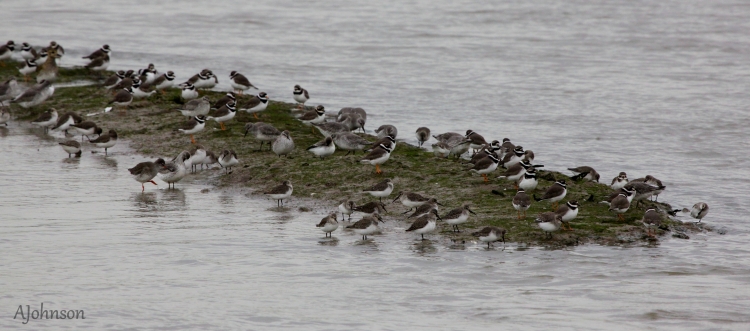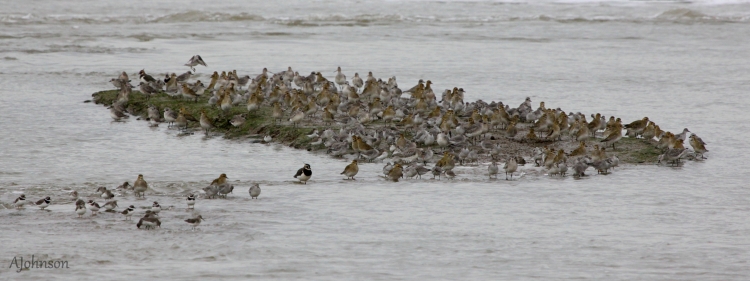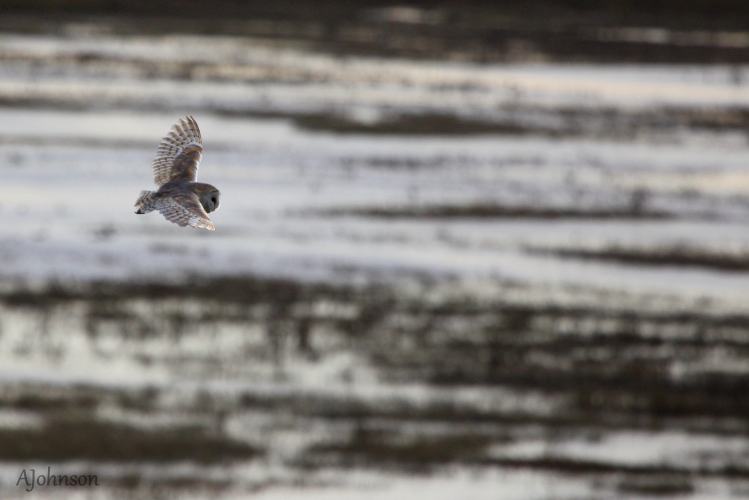The intertidal range at the reserve, created when the sea wall was breached, was a perfect place to watch gathering waders when the tide was rising. The grey clouds were congregating in the sky and the air was filled with the bitter breeze of winter, it was certainly a day for a thick coat, hat, scarf and two layers of gloves. Taking the path to the hide by the intertidal range led me through woodland and scrub, then onto fields, which were filled with skylarks, pipits and finches.
Quickly becoming the stars of the reserve, perhaps not yet overtaking the fame of the Nightingales in spring, are the waders which gather at the intertidal range. Sitting comfortably in the hide I watched the mud being swallowed by the rising tide as I listened to the rushing water and the calls of the waders, who were absorbed in the commotion of the disappearing substrate beneath their feet.
To have a mound of mud filled with golden, grey and ringed plover was a delight. Not only could I watch the flock of golden plover swirl and dance in the air before settling on a remaining piece of mud, but the views allowed me to easily see the colouration variations between the gold and grey plover and observe the detailed plumage and characterful movements of each bird, the large eyes of the plovers an endearing feature. The familiar wader species of redshank, curlew, little egret, lapwing, oystercatcher and dunlin were also about. The new hide gives you a chance to appreciate the exotic as well as the detail in the common species. For example the diving figure of a long-tailed duck which travelled in the water along the opposite shoreline, or the common oystercatcher which hopped along the available mud, not willing to protrude the other leg it had tucked away into the cold air to aid its movement. Waterfowl also graced the opposite bank, including teal and shelduck.
Black-tailed godwits and bar-tailed godwits could also be viewed at a good range from the hide, sometimes standing close together, which allowed me to clearly see the differing profiles and plumage between the two species, with the black-tailed appearing more slate grey in body plumage with longer legs, compared to the more mottled brown appearance of the bar-tailed with its pinkish bill.
The rising water allowed great views of cormorants fishing, with their arched back plainly visible as they dived into the rippling, murky water. Once the tide had finished covering the expanse of mud, the little grebes appeared. They swam past the hide which was now surrounded by water, diving down and occasionally appearing with a fish. One briefly looked at me with its catch, which allowed me a glimpse of the small morsel before it was gone from the world. The trees by the mud were then surrounded by water and made perfect perches for kingfisher, although I am still yet to see the flash of blue I hoped for.
Once you have gorged yourself on a wader bonanza there is nothing better than heading into the warmth of the visitor centre, and sitting with a nice warm drink admiring the view, especially when a graceful barn owl decides to make an appearance mid-afternoon. Gliding across the field, it stopped to hover every so often at the far end of the field, before swiftly flying across the perfect patch of rough grassland, then vanishing into the blinding light of the low afternoon sun. With peregrine and merlin also out in the distance, perching on their obligatory posts, the only bird of prey missing was the marsh harrier. That was until I was on the way out of the car park and one decided to make a fly by in front of the car.
EWT Fingeringhoe Wick is a great place for waders, watching them scurry about, preen and fidget as the water rises was a delight. However if the cold isn’t for you, just sit in the café and enjoy a panoramic view, with hunting birds of prey for entertainment.




